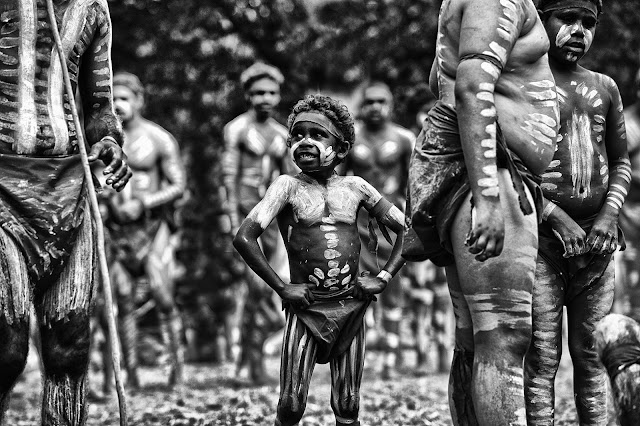Research point: Photographing indigenous people.
Having just returned from Australia from a five week holiday I thought it might be interesting to see how white Australians photograph their indigenous neighbours.
Australia has to be one of the most fascinating places to visit. While there we saw breaching whales, wild koalas, snakes, spiders, cassowary, echidna and whole mobs of kangaroos. What we didn’t see many of were Aboriginal Australians. Yes, there was a small group performing for tourists in Circular Quay Sydney, but on the whole they were absent. A report by The Lowitja Institute calls them “Legally Invisible” The only time we saw them working was at Mossman Gorge where, with the help from the State of Queensland, they have been encouraged to run the rainforest, to which they have been granted stewardship, as a tourist attraction. This has been a wholly successful enterprise which benefits both the Aboriginals and the visitors. The last time we were there, in 2006, we we chased out by these very same people.
The history of Europeans landing in Australia has not been a happy one for the aboriginals. When Captain Cook arrived in 1770 the native population was, it is estimated, between 315,000 and 750,000. Despite this the English Crown deemed it Terra Nullius, meaning unclaimed. The locals, despite having lived there for at least 50,000 years, were dismissed and had no rights.
The attitude of the modern Australian to Aboriginals is, to say the least, mixed. I can’t repeat some of the negative comments I heard, but follow the Australia News link below and you will get a flavour of them. Some of the resentment comes from rights given to Aboriginals that are not given to others. These include hunting and fishing rights, and certain welfare payments.
With all the above in mind I wanted to see how they were portrayed in print. Two photographers sprang out as showing a sympathetic tone and displaying honest images.
The first is Alaster McNaughton, English born and living in Fremantle. The second is Professor Wayne Quiliam, Australia born and living in Melbourne.
Their work displays a deep knowledge of, and respect for their subject. They do not patronise nor do they put their subjects on false pedestals. These are honest pictures of people with a long history and deep rooted beliefs. By working with people they know and respect, these two photographers have avoided the usual traps of artificiality and the distancing of the subjects from their culture.
It is only too easy to find pictures of Aboriginals who have not coped with modern Australia and who turn to drink and/or drugs, but I am not about to re-publish them here.
The lesson would seem to be, get to know the subject and treat them with respect.
Wayne Quilliam
Wayne Quilliam
Alaster McNaughton.
Alaster McNaughton.
References:
AUSTRALIA NEWS. (2011). Australia’s apology to Aboriginals. 2011. [Online] Available at:
[Accessed: 11th. December 2015].
INDIGENOUS LAW CENTRE.(2015). Wayne Quiliam. 2015. [Online] Available at:
[Accessed: 11th. December 2015].
LOWITJA INSTITUTE.(2011) Legally Invisible Report. 2011. [Online] Available at:
[Accessed: 11th. December 2015].
ORIGINAL ART PRINTS.(2011) Alaster McNaughton. Australian B/W Photographer. [Online] Available at:
http://www.desertimages.com.au/art-print/
[Accessed: 11th December 2015].
THE GUARDIAN.(2014). Australia through the eyes of Wayne Quiliam.
[Accessed; 10th. December 2015.




No comments:
Post a Comment